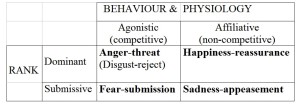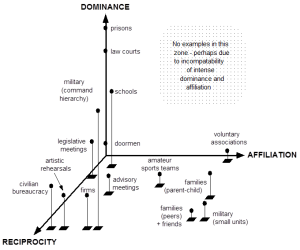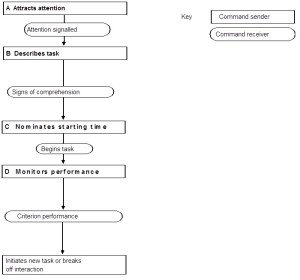Frank Salter, 18 March 2016. The following letter from 1992 had scholarly import but was never published. It reveals some of the nature-nurture debate that has taken place in the specialised field of legal behaviour, in particular with regard to human evolution, innate behaviour, and ethology. The debate continues, though legal studies continues to deny the relevance of biology, as do the humanities and soft social sciences (sociology, cultural anthropology, political science). At the time Hubert Markl (1938-2015) was president of the Max Planck Society, Germany’s peak scientific research organisation, at which I was undertaking post-doctoral research. My letter responded to the following publication:
Markl, H. (1983). Constraints on human behavior and the biological nature of man. Law, Biology and Culture. The Evolution of Law. M. Gruter and P. Bohannan. Santa Barbara, Ross-Erikson: 90-100.
Prof. Dr. Hubert Markl
Department of Biology
University of Konstanz, Germany
26 Oct. 1992
Dear Prof. Markl,
I’ve just read your chapter “Constraints on human behavior and the biological nature of man” in Gruter and Bohannan (1983), Law, Biology and Culture. The Evolution of Law. In that chapter you argue against the usefulness of biological approaches to the study of legal behaviour. I am working in this area of research and am interested to know whether you still hold the views expressed in that paper.
In case your position is unchanged, let me be so bold as to offer a critique of your paper.
You consider biological contributions to the analysis of legal behaviour to be limited in principle for three reasons. Each of these reasons contains theoretically-based insights which do demonstrate limitations. Of particular power is your refutation of sweeping, general claims by sociobiologists and other evolutionists regarding the innateness of normative and legal behaviour. However, it seems to me that the three points fail to show an overall limitation of biology, broadly defined. Taking each point in turn:
(1) (From your abstract) “Since laws are cognitive constructs of the human mind which must be verbalized to become effective, man is the only species in which legal behaviour can be studied. All inferences from animal behaviour studies and from evolutionary considerations are highly speculative with respect to human legal behaviour.”
It is true that laws are cognitive constructs. Indeed it is appropriate, I think, to see laws as a form of social technology. As such they are not (biologically) evolved individual or social characteristics. And since non-human species do [NOT] have such techniques for formulating social rules, in this sense no cross-species comparison is possible. We cannot compare the legal cultures of, say, chimpanzee and human societies. However, these facts leave considerable room for biological contributions to the analysis of components of legal behaviour which are shared with other species.
Mechanisms of rule-governed behaviour are amenable to cross-species comparisons. Rule behaviour need not involve explicit formulation of rules. Members of a group which is delineated in a dominance hierarchy are displaying a capacity for learning and following rules, since a dominance relationship involves learning from experiences of conflict and applying that knowledge to managing relationship in subsequent interactions. More generally, a great number of species are capable of displaying (and inferring) rules of reinforcement and aversiveness, as countless Pavlovian/Skinnerian experiments have shown. Closer to home, primate studies have shown that chimpanzees and some cercopithecines are capable of inferring complex rules in social relationships. A well known example is Franz de Waal’s (Waal 1982; Waal 1986) studies of chimpanzees, in which he found that mature males used strategic alliances to manage dominance relations. Further, alpha males would establish and enforce self-serving (though unspoken) rules, such as: you must not groom that male!
Triadic dominance has clear application to institutions, particularly to their legal culture. It is no coincidence that all laws specify punishments for violators. In societies with sufficient surplus for group task specialization (ie. civilizations) laws are monitored and enforced by police and judiciary. This legal apparatus is only present in human societies but the behavioural mechanisms, at least as they involve dominance, appear to be comparable. (Of course there are other behavioural and motivational factors: conscience, habit, economics.) Comparison is particularly valuable when it is realized that hunter-collector societies, despite possessing speech and thus being able to articulate rules, lack a legal apparatus. In place of police and judiciary, rules are enforced face-to-face using mechanisms of dominance and affiliation, in a manner comparable to hunter-collector groups of other species.
While it is true that legal systems are not natural, the entities (humans) they manipulate are, and the cues which act to limit and coordinate human behaviour must be simulacra of evolved social signals. That is why the science of social signalling, ethology and biologically-oriented social psychology, are especially well suited to the analysis of legal systems.
(2) “In the ontogenetic development of human behaviour there is adaptation of the behaviour to the environment, including culture. There seems no reliable procedure to factor out their relative contribution, particularly since genetic adaptation can be easily phenocopied. Therefore it is only rarely possible to separate a ‘biological’ component of human behaviour from a ‘cultural’ one.”
With regard to your second point about ontogeny, it would seem that advances in method and theory are overtaking the difficulties of untangling nature from nurture in legal behaviour. Behavioural genetics and behavioural endocrinology are delineating heritable and developmental predictors of crime-related behaviours such as alcohol abuse as well as counter-intuitive characteristics such as political preferences and types of rule-breaking such as petty theft and violence (Bohman, Cloninger et al. 1982; Gabrielli and Mednick 1983; Brennan, Mednick et al. 1986; Ellis 1986; Martin, Eaves et al. 1986; Bain, Langevin et al. 1987; Dabbs, Frady et al. 1987; Mednick, Gabrielli et al. 1987; Dabbs, Ruback et al. 1988; Moffitt and Mednick 1988; Fishbein 1990; Ellis 1991) . The emerging lesson is not the naive one that criminality and lawful conduct are inborn, but that legal regimes set environmental conditions which filter out and classify as criminal categories of people based on their patterns of behaviour which sometimes have biological correlates (eg. propensity to include violence in one’s repertoire of aggressive behaviour rather than verbal insult).
(3) Most theories pertaining to the evolution of behaviour in animals (and more so in man) are ‘weak’ theories with some retrodictive but little predictive power; they allow us to define probable modes for behavioral averages but say little about the behaviour of individuals, which is at issue in legal considerations.”
Any theory which successfully predicts average behaviour must be of relevance to law makers and law enforcement agencies. It follows that the biological study of emotions which finds cross-cultural universals in emotional experience and expression (Izard 1979; Fridlund and Izard 1983; Izard, Kagan et al. 1984; Ekman 1989; Izard 1990) has a contribution to make to legislators and administrators everywhere.
In conclusion, imagine for the sake of argument that there are no innate predispositions for law-abidingness or criminality, that human social behaviour is effectively plastic or culture-based. That would certainly limit the applicability of biological theories of legal behaviour as a special category of behaviour. But it would still leave a major role for biology in analyzing the underlying learning process, its physiological (psychobiological) underpinnings, and at the evolutionary level, the phylogeny of behavioural plasticity. In one sense there would be no such thing as a biology of legal behaviour per se. But the same could be said for any basic discipline: there can be no sociology or psychology of legal behaviour because those disciplines can be applied to any number of social phenomena. On the contrary, we find it sensible to speak of a sociological and a psychological approach to jurisprudence. By analogy, at the minimum, there must be a substantial role for biology in studying legal behaviour as well as other deliberate, planned social phenomena.
But biology’s role is more particular in its relevance to law than that. The basic motivational and emotional mechanisms of rule-governed, including normative, behaviour are species specific, as are the physiological mechanisms and primary expression clusters by which they are signalled. Legal culture varies between societies, but the behavioural building blocks from which these diverse systems are constructed are universal. The architectural analogy can be carried further. The limited variety of building materials is reflected in the limited variety of legal systems. There are many different punishment mechanisms in use, but all systems rely on punishment of one kind or another and to some degree. Likewise, conscience or internalized norms is universal, at least to stable systems.
I hope I haven’t strained your busy schedule too much with this lengthy letter.
Yours sincerely, Frank Salter
References.
Bain, J., R. Langevin, et al. (1987). Sex hormones in murderers and assaulters. Behavioral Science and the Law, 5, 95-101.
Bohman, M., C. . Cloninger, et al. (1982). Predisposition to petty criminality in Swedish adoptees 1. Genetic and environmental heterogeneity. Archives of General Psychiatry, 39, 1233-1241.
Brennan, P., S. A. Mednick, et al. (1986). Congenital determinants of violent and property offending. In The Development and Treatment of Childhood Aggression, (ed. D. Pepler), Erlbaum, New York.
Dabbs, J. M., R. L. Frady, et al. (1987). Saliva testosterone and criminal violence in young adult prison inmates. Psychosomatic Medicine, 49, 174-182.
Dabbs, J. M., R. B. Ruback, et al. (1988). Saliva testosterone and criminal violence among women. Personality and Individual Differences, 9, 269-75.
Ekman, P. (1989). The argument and evidence about universals in facial expressions of emotion. In Handbook of Social Psychophysiology, (ed. H. Wagner and A. Manstead), pp. 143-164. Wiley, New York.
Ellis, L. (1986). Evolution and the nonlegal equivalents of aggressive criminal behavior. Aggressive Behavior, 12, 57-71.
Ellis, L. (1991). Monoamine oxidase and criminality: Identifying an apparent biological marker for antisocial behavior. Journal of Research in Crime and Delinquency, 28, 227-251.
Fishbein, D. H. (1990). Biological Perspectives in Criminology. Criminology, 28, 27-72.
Fridlund, A. J. and C. E. Izard (1983). Electromyographic studies of facial expressions of emotions and patterns of emotion. In Social Psychophysiology: A Sourcebook, (ed. J. T. Cacioppo and R. E. Petty), pp. 243-86. Guilford Press, New York.
Gabrielli, W. F. J. and S. A. Mednick (1983). Genetic correlates of criminal behavior. American Behavioral Scientist, 27, 59-74.
Izard, C., E. J. Kagan, et al. (1984). Emotions, Cognition, and Behavior, Cambridge University Press, Cambridge.
Izard, C. E. (1979). Expression of emotions as a transcultural language in social interaction and theatrical performance. In Aspects of Nonverbal Communication, (ed. W. von Raffler-Engle), Swets & Zeitlinger, Amsterdam.
Izard, C. E. (1990). Facial expressions and the regulation of emotions. Journal of Personality and Social Psychology, 58, 487-489.
Martin, N. G., L. J. Eaves, et al. (1986). Transmission of social attitudes. Proceedings of the National Academy of Science, 83, 4364-4368.
Mednick, S. A., W. F. Gabrielli, et al. (1987). Genetic factors in the etiology of criminal behavior. In The Causes of Crime, (ed. S. A. Mednick, T. E. Moffitt and S. A. Stack), Cambridge University Press, Cambridge.
Moffitt, T. E. and S. A. Mednick, Ed. (1988). Biological Contributions to Crime Causation. Martinus Nijhoff. Dordrecht, The Netherlands.
Waal, F. B. M. d. (1982). Chimpanzee Politics: Power and Sex Among Apes, Jonathan Cape, London.
Waal, F. B. M. d. (1986). The integration of dominance and social bonding in primates. Quarterly Review of biology, 61, 459-479.




